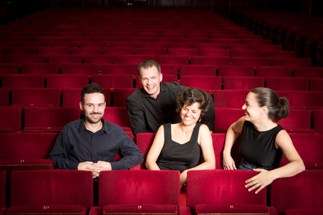|
Back
Life Begins at 70 New York
Weill Recital Hall, Carnegie Hall
03/09/2018 -
Franz Schubert: Quartettsatz in C minor, D. 703
Leos Janácek: Quartet No. 2, “Intimate Letters”
Ludwig van Beethoven: Quartet in E-flat major, Op. 127
Elias String Quartet: Sara Bitlloch, David Grant (violins), Simone van der Giessen (viola), Marie Bitlloch (cello)

D. Grant, M. Saving, S. Bitlloch, M. Bitlloch (© Benjamin Ealovega)
“I don’t deliver my feelings to the tender mercies of fools.”
Janácek to Kamila Stösslová, February 20, 1928
Certainly Stravinsky had his early walkouts and César Franck had to deal with his wife storming out of the hall at the premiere of his Piano Quintet, clearly written for his mistress, but the over 70 Leos Janácek gave not even a smidgen of a hoot when the public was reminded of his fondness for another.
Although it is easy to be salacious about the relationship between Janáček and Kamila Stösslová, a woman almost 40 years younger than he, it is much more profound and rewarding to think of the pair as passionate but platonic friends. What is crystal clear is that the composer’s renaissance, especially on the operatic stage, was largely due to his reawakening of passion that would otherwise have passed him (and us) by. We have, in large part, Kamila to thank for The Cunning Little Vixen and Káťa Kabanová as well as instrumental works like the Sinfonietta and his highly effective Slavonic Mass. The work directly inspired by this remarkable woman is the String Quartet No. 2, subtitled Intimate Letters.
In this remarkable hall (the best sound-space in New York) this ostensibly British quartet began with Schubert’s Quartettsatz. They are British as a group, however the Bitlloch contingent is French-Catalan and Mr. Saving wasn’t even present, excused by a medical problem. He was replaced by Simone van der Giessen, a native of Amsterdam and one of the tallest violists that I have ever seen. This introductory realization was remarkable for its rich blending, marked by subtle but affecting dynamic changes. All in all, a very good start to a promising concert.
However, the evening went off the rails when these acolytes decided to imitate their mentors by including a lecture and a reading as a passageway into the world of Janácek. Somewhere on their educational journey, they acquired this bad habit of breaking the poetic content of their presentation with the most amateur of explications. Ms. Bitlloch the cellist arose and attempted to educate us unwashed on the nature of the relationship between composer and muse. Not only did this maneuver put a damper on the evening, but it was delivered in the most amateurish of ways. Speaking without a microphone, this cellist could hardly be heard at all, exhibited some rather cringe-worthy grammar, and when she decided to read to us one of the letters written by the composer to his muse I, for one, was thankful that she was basically inaudible. Somehow I don’t think that her teachers, including Győrgy Kurtág and Gábor Takács-Nagy, can be held totally responsible, as this need for explicative venting seems to have now wormed its way into concert life. Ironically, in an art-form totally devoted to the beauty and majesty of sound, this type of static has plagued innumerable presentations of the past dozen years. Let us hope that these promising acolytes can “unlearn” this blasphemy relatively soon. From almost the first note, the woman seated next to me slept through virtually this entire performance.
This was a shame as the musical section of the evening was very satisfactory. This iteration of the piece was stellar in its non-verbal communication. The passion with which the quartet threw itself, especially during the folk-song inspired sections, was exemplary. This is a difficult piece to pull off, the rhythmic permutations alone helping to hoist its degree of difficulty, and the quartet passed the test admirably. There were hints of Charles Ives in this performance and that is always a good thing. The inclusion of a substitute violist did not cause any undo coordination problems. It is clear that these young people have a bright future ahead.
The Beethoven ended the evening with an explanation point. Now in more familiar territory the ensemble really shone, bringing out the rich melodic lines, somewhat hidden in the score, to the front of the ear and keeping their ecstatic outbursts under precise and remarkable control. There seems to be a bright future ahead for these acolytes as long as they keep their comments to themselves.
Fred Kirshnit
|